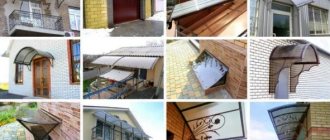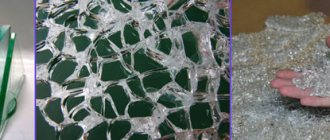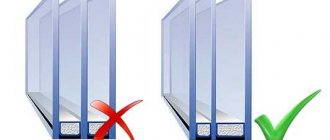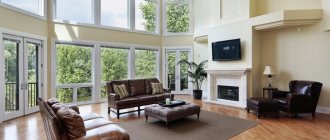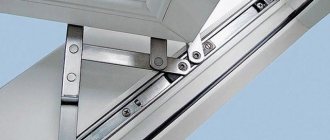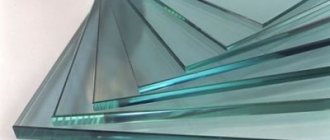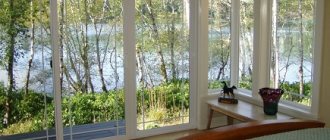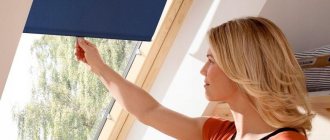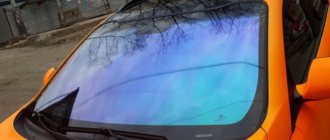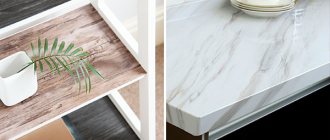Types of mirror films
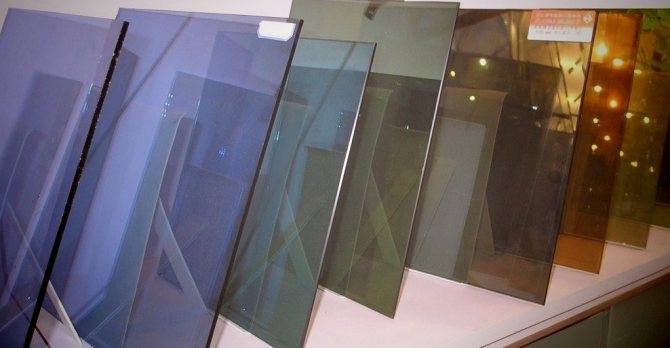
Fig. 3. Varieties of mirror film
There are several types of mirror films used for application on insulating glass units:
- film for internal application. Metallized structure, which is installed indoors on the inner edge and inside the glass unit from the side of the building. It is distinguished by a wide range of colors and the ability to choose any degree of shading;
- mirror metallized film for outdoor use. Glued from the street side. A feature of this type of film is the presence of an additional protective element that protects the glass layer from external influences. It can only be made in two versions: dark or light metallic. The film does not reflect the sun's rays, letting them into the room without interference;
- high quality film (spatter). Attached from the side of the room. Reflects up to 40% of the sunlight in summer, so you can stop using blinds or curtains. It has many shades: blue, yellow, greenish, gray. There is a choice of the degree of light transmission. Replacement in case of damage is quick, effortless;
- combined. It has a protective function and the ability to reflect the sun's rays from the surface. There is a choice among a wide range of colors. You can choose different degrees of light transmission. Protects against cracks, overheating, UV rays dangerous to the body. Attaches to the outside.
Each type of film is capable of having a different level of burglary resistance. The most durable options are able to protect against destruction even during explosions, do not break from a direct shot from a pneumatic weapon. The material cracks under significant impact, but remains intact.
Reflective glass units
To protect objects from the sun, not single glazing, but reflective glass units are usually used. Such products are suitable for completing windows made of plastic, wood and aluminum profile systems, as well as for solid facade glazing. Only in this way it is possible not only to solve the problem of excessive insolation and ensure privacy, but also to reduce heat loss, as well as the level of noise coming from the street. In addition, even a hard reflective coating is best located on the inside of the air chamber of the insulating glass unit. This is especially true for objects located on polluted streets.
It is also worth noting the lack of a mirror effect in such double-glazed windows in the dark. If the lights are on in the interior, everything that happens in the rooms will be perfectly visible from the street. Blinds or curtains remove the problem, but some property owners for a while remain confident that they are not visible during the entire time of the day, and sometimes they get into unpleasant situations because of this. Also, reflex double-glazed windows are afraid of severe overheating. In such cases, they can even become stained and lose some of their properties.
Advantages of Mirror Film
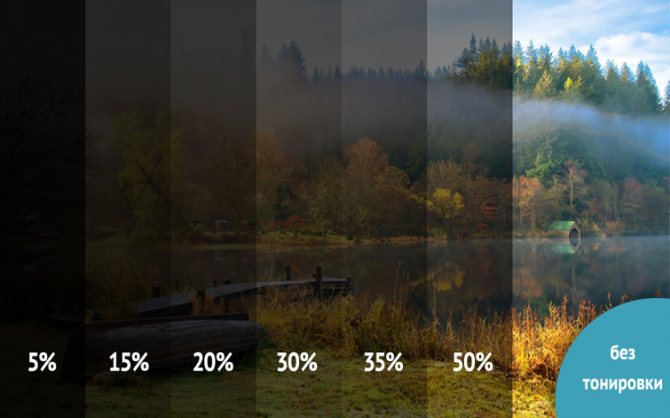

Fig. 4. The degree of light transmission of the mirror film
There are many advantages to using mirror film. It increases surface stability and strength. When using technology outside, it becomes very difficult to break glass from the street, although it is knocked out of the room without any particular difficulties. Any film protects well against ultraviolet radiation.
The rays are reflected from the surface.Strong overheating of glass when using the technology is excluded, which increases the operating time of furniture and finishing materials of the room. One of the important advantages is the ability to trap accumulated heat. In the cold season, this property is especially important.
For those living in the private sector or on the lower floors, an important property of the film is the ability to protect it from prying eyes. When cracking, any type of structure will hold the fragments, will not allow even the smallest particles to scatter. It can be used on glasses of any size, double-glazed windows with various configurations. The user selects a convenient shade, light transmission and strength.
Mirror tinting of a glass unit
The second, more economical option is the mirror tinting of the glass unit. Often, plastic windows are tinted to protect them from heat. This allows you to save both on the purchase of an air conditioner and on electricity bills.
The film has a different specularity and degree of shading: considering all the features of your room, you can choose the optimal one for yourself.
Acting as a reflector, the mirror film prevents glare from the sun from passing through. This helps both to protect objects in the room from burnout, and to save your eyes from the unwanted effects of bright rays.
Your plants will also preserve this, but in this case, you should take care of the safety of especially heat-loving plants, as this can negatively affect their growth and development.
Another important feature of the mirror film is its durability: if the glass breaks for one reason or another, the glass will crack, but will remain inside the film that fixes it.
Thus, it will not scatter throughout the apartment and will protect people in the room from injury, and will also keep the surrounding objects intact. This feature will be useful for residents of disadvantaged areas or those who live on the ground floors and are worried about both the safety of the windows themselves and because of their property in general.
In addition, mirror tinting will allow you to show your individuality and diversify the appearance of the window, having a wide range of color shades, mirror tinting film gives any building an interesting look: if you wish, you can even order tinting with photo printing.
But if your windows are on the north side or are surrounded by trees, the view of your apartment may be gloomy, since the film does not radically, but still reduces the amount of visible light.
Manufacturing technology
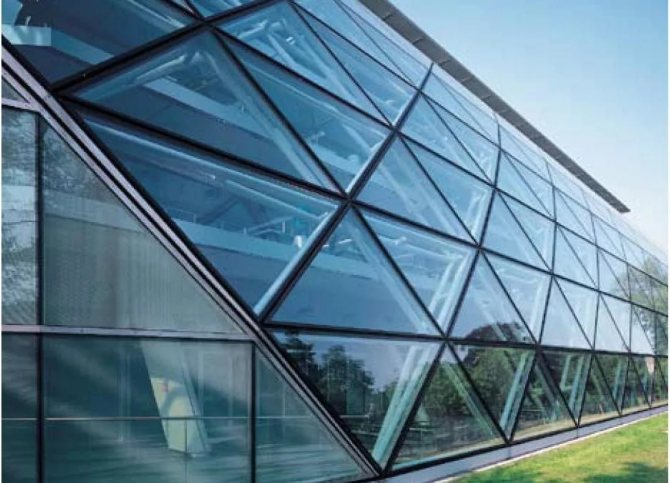

Fig. 5. Examples of using mirror film
The main component in the manufacture of mirror films is polyester. Raw materials must be thoroughly cleaned and sorted. The material is multilayer, each layer does not exceed 20 microns in thickness. You can add additional functions by adding additional spraying. The manufacturer company rolls the layers to create a homogeneous base. After the necessary actions under high temperature, a single structure is obtained.
It is important to choose a quality base so that the final material meets all the requirements. One of the prerequisites for the finished product is the absence of distorted reflection when looking at the surface. The condition is achieved by selecting interlayers of the same thickness. The manufacturing technology is constantly being improved, the physicochemical properties of the components used are improving.
Now it is difficult to find a film on which scratches appear when washing with abrasive substances, although there was no other option before. When the concentration of any of the constituent substances decreases, the properties of the coating also change, for example, the degree of light transmission. The glue used is one of the important components.It works at the molecular level, connecting all the elements together. If you buy a high-quality mirror finish, its use lasts for several decades.
What types of double-glazed windows are there?
Mirrors are more often covered with a film, because their production is cheaper, and this option is more affordable for the buyer. The protection obtained by using the film is optimal. It is not difficult to apply it, you can even do it yourself on long-established windows.
It will allow you to adjust the lighting in the room, will not allow the too bright sun to overheat the room. This means that interior items will not fade, the color of the wallpaper, flooring will last longer, it will be noticeably cooler in summer, and your eyes will be less tired. At the same time, indoor plants will receive enough light.
Mirror glass units have approximately the same functions and properties, however, they are more durable. If the film can swell over time or receive physical damage, then the spraying cannot be removed from the glass unit. On the other hand, this creates certain inconveniences: if you want to change the light transmission capacity of the structure or its design, then the sprayed windows will have to be dismantled, while the film is simply peeled off.
Most often, mirror film is used for glass decoration. If desired, the owner can choose any color he likes, which will help to give the window a suitable appearance for any interior or facade.
Reflective glass
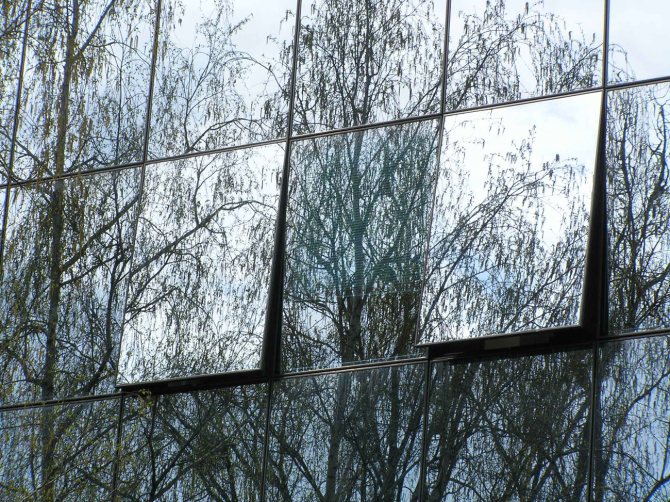

Fig. 6. An example of a reflective glass
Differs in a number of properties, the ability to absorb light reaches 70%. Manufacturing technology consists in applying a layer of metal oxide. Strength characteristics and surface impact resistance are increased.
There are several types of reflex glasses, differing in their features and manufacturing method. Types of materials:
- Absorbing. The main function is to absorb harmful solar radiation.
- Reflective. Protect from sunlight.
- Combined. They combine the positive features of each type of product.
Absorbent Reflex Glasses
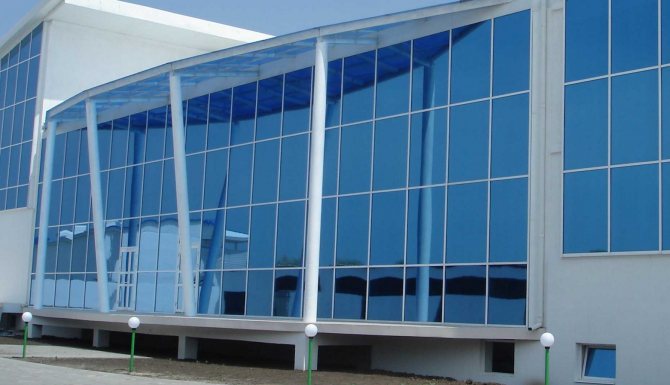

Fig. 7. Absorbent reflective glass
They are made using a special technology: the blanks are placed in a furnace, kept there at a temperature of 650 ° C, followed by heating. Thickness, width, height and shape are given with the help of special rollers. After the molten consistency is subjected to treatment with crystals of metal oxides. After applying the required number of layers, the material is sent for hardening.
Hardening is carried out by blowing air. Strength increases, it becomes possible to absorb light rays. Glass, if an additional colored layer is not installed - spraying, has a green-blue color.
Depending on customer requirements, glasses can transmit from 30 to 80% of light rays. Protection against infrared light is high: no more than 30% of the rays are transmitted through the surface. The features of the technology imply a high degree of protection, but glass has some negative properties. During strong solar activity, the surface of the material can heat up significantly. The surface must warm up and cool down evenly - the material can crack with significant temperature fluctuations.
Reflective reflective glasses
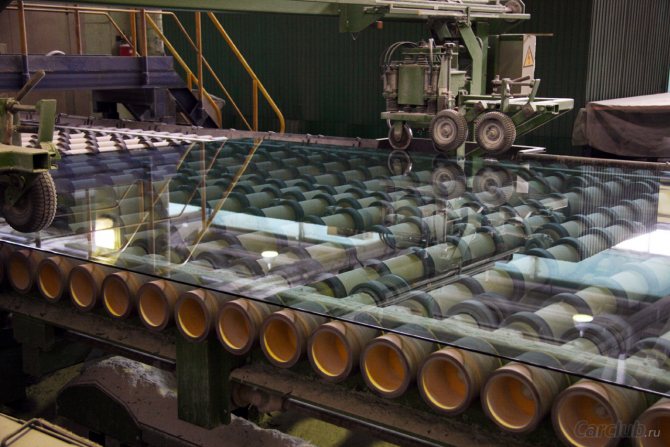

Fig. 8. Glass making
The material is made in almost the same way as ordinary glass. Differs in the application of a special coating at the last stage of work. The workpiece is placed in the oven, heated under the influence of high temperature. With the help of special rollers, the material is given the required shape and thickness. As with absorbing reflective glasses, the surface is tempered by means of an air stream. This increases all the necessary characteristics.
After partial cooling, a thin layer of ceramic, polymer or oxide - metal coating is applied. Further, complete cooling is required. When the workpiece cools down, the surface has a silvery color, and due to the last stage of processing, high reflective properties appear.
The peculiarity of glasses is the ability to reflect sunlight to the required level. During operation, there is no heating of the surface, no changes in composition. A plastic double-glazed window of this type is rarely used due to its high cost.
Combined reflective glasses
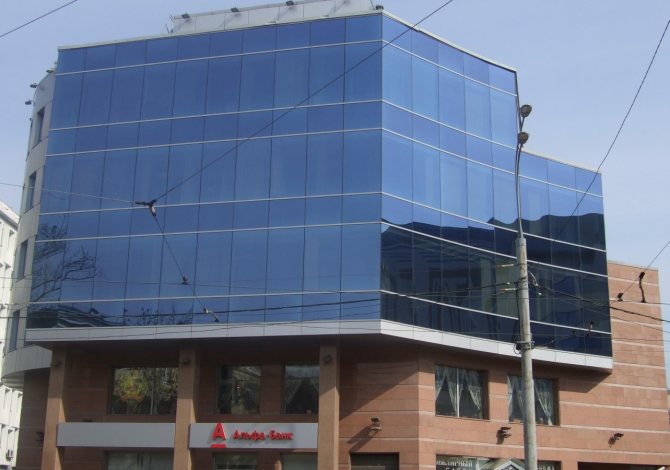

Fig. 9. Reflective glass
This type of glass is capable of absorbing and reflecting sunlight. Manufactured according to standard technology, but with additional improvements. After heating and shaping, 4 layers of metal oxide are applied. With the help of air, the surface is hardened. Further, after partial cooling, another layer is applied - silver and the workpiece cools down.
Solar radiation reflects off the surface to a predetermined degree. Harmful radiation is almost completely absorbed. One of the additional benefits is the significant degree of heat retention in the room. This type of glass is expensive to create, as it requires a large number of interlayers. The process is laborious, long, and the final cost of the material is high.
The thickness of the product can be 6, 8, 10 mm. The length varies according to the preferences of the customer. For example, glass in large shopping centers is often made with dimensions of about 6x3 meters with a 6 mm thickness.
Advantages of Reflex Glasses
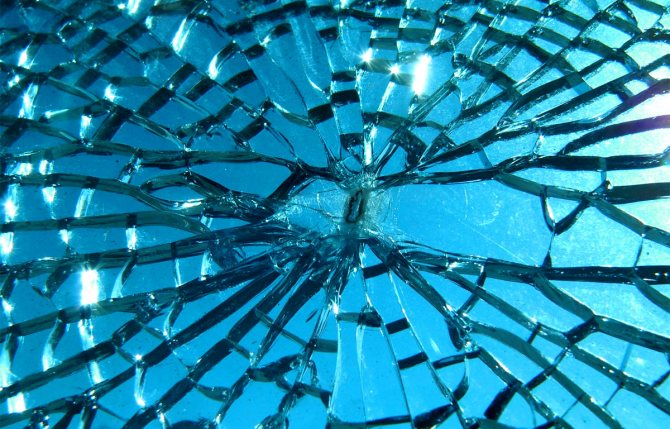

Fig. 10. Breaking coated glass
Reflective glasses of mirrored glass units have the following advantages:
- high aesthetic qualities - the use of modern technologies allows you to give the material the necessary shade;
- the possibility of improving the microclimate of the room due to the property of partial transmission of light rays;
- high reflective properties do not allow you to see what is happening behind them. There is a choice of specularity: from minimum to full;
- due to processing and hardening, they have high strength;
- it is possible to laminate and additionally harden;
- if it is necessary to increase the characteristics, it is possible to apply additional layers;
- the building acquires a presentable appearance thanks to panoramic glazing;
- can be used in single glass, double-glazed windows.
Purpose of sheet polished glass
Polished sheet glass is a versatile product used for the production of insulating glass units, mirrors, glass doors, portals, when creating external enclosures, and other architectural structures, that is, in places where there are high requirements for light transmission.
Glass is used in a wide variety of combinations, while the main goal is to increase protection:
- Protection against heat loss thanks to the application of low-emissivity coatings such as Planibel Top N and Planibel Plus from Glaverbel.
- Protection against overheating by means of tinted glass or glass coated with metal oxides with a sun protection function.
- Noise protection - due to the use of a special glazing technology using glasses of various thicknesses.
- Protection against destruction under significant mechanical loads, due to heat treatment of glass in the form of tempering and heat-strengthening.
- Protection.
Reflex glass manufacturing technology
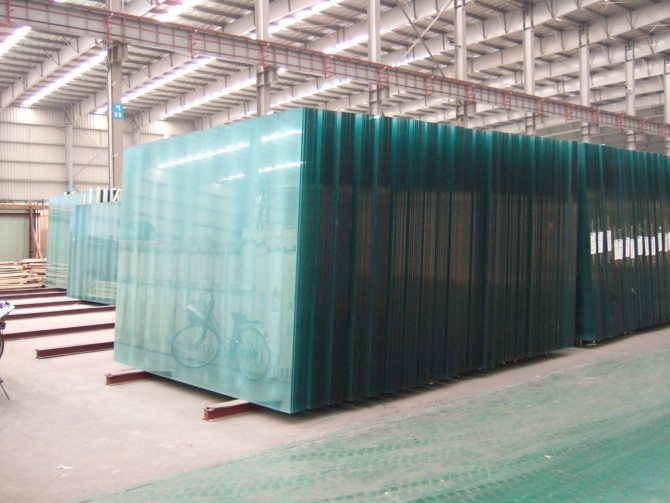

Fig. 11. Glass making
Reflective glass is manufactured according to the same rules as the production of plain glass. The subsequent additional processing is different. First, the workpiece is heated in a furnace to a temperature of 650 ° C to soften the existing mass. After leaving the oven, the hot future product is cut.The saws in the form of rollers give the necessary parameters of width, length, thickness. If necessary, the structure is given a special shape.
Then the glass must be slightly cooled and an additional layer of metal oxide crystals applied to give strength and increase protection from sunlight. There may be several layers, depending on the degree of light transmission in the finished product. To prevent cracking under minimal pressure, the workpiece is hardened.
Air masses under pressure blow the structure until it cools completely, increasing its strength. Light rays are passed through even worse after the procedure. If necessary, a color chosen by the client is given: by spraying it is possible to achieve the desired color.
Depending on the type of reflective glass, the number of additional layers can be changed. The density of the metal oxide layer on the surface is not constant. Silver oxide is added to enhance protection against harmful solar radiation.
Classification of types of glass
- Flat float glass;
- Energy saving (low emission);
- Mass toned (selective);
- Reflex (sun-reflecting);
- Reflective + energy saving in one;
- Enameled;
- Special (fire-resistant, heat-strengthened, hardened, laminated, insulated glass units with electric heating).
Flat float glass
The mixture of raw materials is charged into the furnace and diluted with water to separate the required components from the dirt. In the firebox, the glass production process goes through 3 main stages:
- melting, when the raw material is melted at a temperature of 1550 C;
- purification, when the molten glass is homogenized (becomes homogeneous) and gas bubbles are removed from it;
- a change in the temperature regime, when the melt is cooled to a viscous state, convenient for pulling it through the tin bath.
Further, liquid glass is poured onto the surface of a bath filled with molten tin, the temperature of which is about 1000 C. The bath is made in the form of a tape, the thickness of the tin is 6-7 mm. Due to the high viscosity of glass, it does not mix with liquid tin, while providing a very smooth contact surface of both materials, which determines a smooth, high-quality glass surface. The thickness of the future glass sheets is determined by the amount of glass poured into the bath.
After the tin bath, the already solid glass in the form of a ribbon passes through a cold tunnel called the lehr. The temperature of the glass gradually decreases from 620 to 250 C. The cooling process continues until the condition of the glass allows cutting and processing.
The chilled glass tape is cut on automatic tables into sheets of the desired size. Only this method of production is possible to obtain glass of the M0 brand.
Energy saving (low emission) glass
Windows account for more than 40% of heat losses in a building, which consist of:
- thermal conductivity;
- convection;
- thermal radiation.
Heat loss according to the first two points can be reduced by using double-glazed windows in the glazing, but the main share (2/3 of all heat losses of the window) falls on thermal radiation.
These losses can be reduced by using energy-saving glass with a low-emissivity coating (LowE) in the insulating glass units. This coating is applied to the glass surface during its production by cathodic sputtering in a magnetic field under vacuum conditions. The coating has the ability to reflect the infrared (thermal) part of the light spectrum. Glass provides good thermal insulation in winter, preventing heat from escaping outside the room, while at the same time having good light transmission.
Tinted in bulk (selective)
Tinted glass is glass that is mass-colored during the melting process in a foundry.Coloration in blue, bronze, gray or green color leads to strong absorption of the corresponding parts of the spectrum. Due to absorption, glass absorbs about 50% of the energy of solar radiation, and subsequently reflects the energy, directing it outward.
When designing facades, it is necessary to take into account the possibility of spontaneous glass breakdown due to the absorption of too much heat and subsequent thermal shock. To avoid this, it is recommended to use heat-strengthened or tempered tinted glass.
Some types of tinted glass:
- Saint-Gobain
: Parsol green, gray, amber, bronze, pink; - Pilkington
: Optifloat (colors: same), Arctic Blue (blue); - Graverbel
: Planibel (same colors + blue).
Reflective glass
Reflective glasses provide more effective protection from the sun due to a reflective layer applied to the glass surface, which is applied to transparent or mass-tinted glass during its production. Its task is to reflect both daylight and solar heat.
The use of such glass in glazing will reduce the heating of the room from sunlight, reduce the cost of air conditioning the room, ensure the optimal energy balance of the building, and also decorate (mirror reflection effect).
Reflective + energy saving in one
- They are made by spraying two layers: reflex and energy-saving (reflex and energy-saving in one);
- Provide at the same time protection of the building from excessive heating and energy saving;
- They save costs for both air conditioning and heating.
Enameled glass
With some deviation, glass obtained by sintering paint with glass at a high temperature can be attributed to colored glasses. This composition is called enamel (stemalite). This glass is used to close the floors.
Fireproof glass
This glass is a colorless, transparent laminated glass where float glass sheets are held together with a special gel. The gel swells on contact with fire, turning into an insulating "foam". Depending on the design of the glass, it provides protection up to 120 minutes. Also safe glass. Fire resistant glass is subdivided into classes:
- Class E - integrity (protection against flame and combustion products);
- Class W - partial thermal insulation (up to 15 kW / m2);
- Class I - maximum thermal insulation.
The number following the class indicates the time during which protection is guaranteed. So, if the glass provides protection from flames and gases for 30 minutes, it is designated E30; if the glass also provides protection against high temperatures, it is designated EI30, etc.
Strained glass
Tempered glass is a sheet glass that has undergone a special heat treatment in order to increase its mechanical strength and ensure a safe nature of destruction.
- does not collapse from accidental household shocks;
- has a high thermal resistance, which allows it to be used for facade glazing;
- when destroyed, it forms small, safe glass fragments that are not capable of injuring people.
The tensile strength of tempered glass in bending can reach 250 MPa, which is more than 5 times higher than the tensile strength of ordinary sheet glass, and the impact strength of tempered glass is 3-4 times higher than that of ordinary glass. An increase in mechanical strength leads to an increase in heat resistance. Ordinary glass has a thermal resistance of about 400 ° C, tempered glass - up to 1800 ° C. This allows the glass to resist destruction due to overheating or temperature extremes.
Laminated glass
Triplex is a composition of two or more layers of glass interspersed with layers of resin or film.Such glass has good protective properties - when broken, the fragments remain glued to the intermediate layer.
Depending on the intermediate layer used, the triplex can acquire different properties. Double-glazed windows and architectural glass factory offers triplexes:
- Noise reducing. Triplexes with such properties are able to reduce the noise level;
- Impact resistant. Triplex with increased durability. A different combination of glass and resin layers allows achieving different strength classes: A1-A3 - impact resistant, B1 - B3 - penetration resistant, B1-B6 - bulletproof.
- UV protective. Triplexes capable of limiting ultraviolet radiation entering the room.
Self-cleaning glass "Pilkington Activ ™"
Pilkington Activ ™ Self-Cleaning Glass is a neutral-colored glass with a special titanium oxide coating that is self-cleaning from organic contaminants. The coating is sprayed onto the surface of the finished glass that has not yet cooled down, imparting two new properties to it:
The surface of the glass becomes hydrophilic — the water that gets on the glass does not collect in drops, but evenly wets the surface. The coating ensures the catalytic decomposition of organic contaminants by the natural UV radiation from the sun (the so-called photocatalytic process).
Thanks to these unique properties, the coating intensively decomposes the dirt that has got on it, preventing it from adhering tightly to the glass surface. All contaminants are easily washed off by rain, since the hydrophilicity of the coating ensures uniform spreading of raindrops. After drying, no streaks and stains remain on the glass. With Pilkington Activ ™ glass, you have much less to worry about keeping your windows clean - the glass cleans itself!
Pilkington corporation experts predict that the coating will last for at least 20 years without losing its cleaning properties. Pilkington Activ ™ self-cleaning glass does not require any special maintenance. In appearance, the glass is practically indistinguishable from ordinary window glass, only under oblique illumination a slight bluish tint of the coating is noticeable. The light retention of self-cleaning glass does not exceed 7% - even the smallest contamination of the window panes retains the light more.
Double-glazed windows with electric heating
To create the maximum comfort of a person in a room, double-glazed windows with electric heating have recently begun to be used in window blocks, skylights, greenhouses and conservatories. Electric heating of a glass unit evens out the temperature difference between the inner glass of the glass unit and the air in the room, thereby reducing the downward flow of cold air near the glass surface, and reducing the circulation of cold air allows you to create the most comfortable conditions in the room with minimal heating costs. Externally, a double-glazed window with electric heating is no different from a conventional single-chamber double-glazed window. It uses tempered energy saving glass. Tempered glass provides electrical safety, and the inter-glass rail eliminates the "cold bridge" along the entire perimeter of the glass unit.
Such a glass unit can be used in three modes depending on the power and solve various problems:
- power at the surface 50-100 W / m2 To increase the comfort in rooms. The surface temperature of the window is +15 - +25 C.
- power on the surface 100-300 W / m2 For space heating - an additional or main source of heat. The temperature of the inner surface of the glass is + 20 ° - + 40 ° C.
- power at the surface 50-600 W / m2 Specific application - thawing of snow and ice and the main source of heat. The temperature of the inner surface of the glass, depending on the object, is up to + 110 ° C.
The main advantages of an electrically heated insulating glass unit:
- Elimination of condensation on the glazed surface;
- Removal of snow and ice;
- Elimination of draft - directed flows of cold air;
- Possibility of joint use with the security alarm system;
- Maintaining a constant indoor climate.
Hide
Mirrored windows are quite an interesting solution not only for cafes, but also for residential or office premises, especially those located on the ground floors. They will provide a comfortable stay in the room, give a sufficient amount of light, but become impenetrable for views from the street, and will be able to reflect excess ultraviolet light.
Disadvantages of mirrored glass units
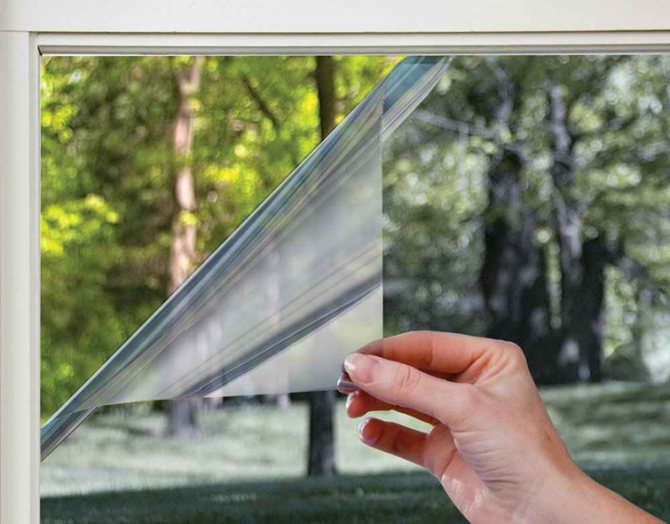

Fig. 12. Sticking film
Mirror glass units are made in a special way. They are capable of reflecting ultraviolet rays well. Infrared radiation, which is harmful to the human body, is almost completely absorbed. The high sun-protection effect does not interfere with the penetration of a sufficient amount of light into the room, the choice of the degree of penetration of sunlight. Natural lighting ceases to be harsh, becomes pleasant, warm.
In addition to the listed properties, the external characteristics of the building are increased, due to which materials are increasingly used in the construction of entertainment centers or sports complexes. The price depends on the properties of the surface. There are a number of disadvantages that you should know before buying products:
- Reflective insulating glass units can deteriorate if overheated. Visible spots appear on the surface, spoiling the appearance.
- The use of film as a protective coating for double-glazed windows requires time for pasting and money injections. Artificial spraying is an order of magnitude more expensive than film.
- If the protective film is incorrectly adhered, the appearance may be damaged. It is unacceptable to leave burrs at the edges (touches the protective film), as they will begin to curl up, spoiling the attractiveness of the appearance.
- Reflective properties disappear at night, when it becomes an order of magnitude brighter indoors than outdoors.
Double-glazed windows with a matte surface.
Frosted glass is mainly used in bathrooms, meeting rooms or in the manufacture of furniture.
These glasses are of four types:
- Satin. The most common and economical glass. The glass is dull due to the acid treatment of the glass. It transmits light very well and, in comparison with other methods of making glass matte, is the leader among such glasses due to its strength and capabilities. This glass can be not only monolithic matt, but also with a matte pattern.
- "Kreset" .. Glass with relief patterns. Such glasses were very common in the 20th century, although they are still in demand today. Before the appearance of "satin", "kreset" had a large number of patterns, but over time, due to a decrease in demand, only one or two patterns remained in use.
- "Sandblasting" Dullness is given by processing the glass with sand. The sand is dispersed by an air stream and directed into the glass, then the sand particles knock out the glass chips, giving the glass a matte finish. This method has a disadvantage, since due to the knocking out of glass particles, it becomes more fragile than "satin" or "kreset"
- "Smart" glass. These are the most advanced technologies for making glass matte. "Smart" translated from English is smart. In short, such glass becomes frosted when electricity is disconnected from it, and transparent when turned on. This effect is achieved due to nano particles that are located between two glued glasses (triplex). Without the supply of energy, the particles are in a chaotic state and when looking at the glass, a matte effect is visible, and when electricity is connected to the glass, an electromagnetic field is formed, which aligns the particles strictly with their end to our gaze and because of their small end area, the glass becomes transparent.The disadvantage of such glass is still the price and consumption of electricity.
Do you need tinted and reflective windows and who
If you do not take into account the "smart" glass, then the use of glass with the effect of reflection is advisable and even necessary for interiors that do not imply shading with curtains and blinds. These can be shopping and entertainment centers, offices, apartments and houses with panoramic windows. The cost of a double-glazed unit does not exceed the cost of an ordinary one by more than 10%, which allows you to save on the purchase of curtains or on the repair of a constantly fading interior.
Pros and cons of tinted and reflective coatings:
- Reflective and tinting coatings are easy to use and do not interfere with the interior in comparison with blinds.
- Compared to blinds, it reflects the energy of the sun much better and does not heat up like aluminum louvers in summer.
- Maintenance free.
- A wide variety of colors. In films, the variety of colors is not only huge, but it is also possible to choose them with different percentages of the reflection of the energy of the sun, the environment and the darkening of the room.
- The downside is that with the lights on inside the room at night, everything will be visible from the street. But this is significant if the windows are low above the ground.
- An important plus is the additional sound insulation due to tinting films, and also increases the impact resistance of such glass.
Scope of application of mirrored glass units
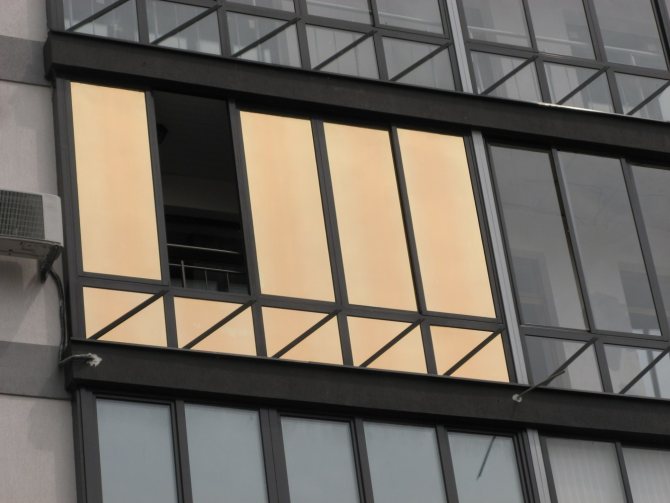

Fig. 13. Using a mirror glass unit
Most often, the installation is carried out in shopping centers, sports complexes, in office buildings. Recently, owners of private houses have begun to use modern technology in their households. Such structures are distinguished by a special style, beauty, modernity. It would be appropriate to equip any housing with such an innovation - there are no restrictions on the use.
If you have sufficient funds, you can apply a reflex type of glass. Here, a special manufacturing technology stands out, which allows you to protect the premises from harmful influences. Stylish appearance will help to fit in the innovation with any type of home decoration. Like a protective film on a mirrored glass unit, reflective glasses allow you to protect your home from prying eyes.
How are mirror designs used?
Mirrored glass in windows, in fact, is ordinary, therefore, they have the same technical characteristics as the usual transparent double-glazed windows. Its main difference from ordinary glass is specularity, due to which it becomes impossible to see what is happening inside the premises from the street side. In addition, such a double-glazed window protects well against infrared radiation, due to which a pleasant microclimate appears in the room. In summer, the rooms will be noticeably cooler, and in winter, heating costs will decrease.
Outwardly, such glasses look attractive. The building, equipped with them, acquires a stylish, modern appearance; however, mirrored windows go well with classical facades, becoming invisible against the general background.
